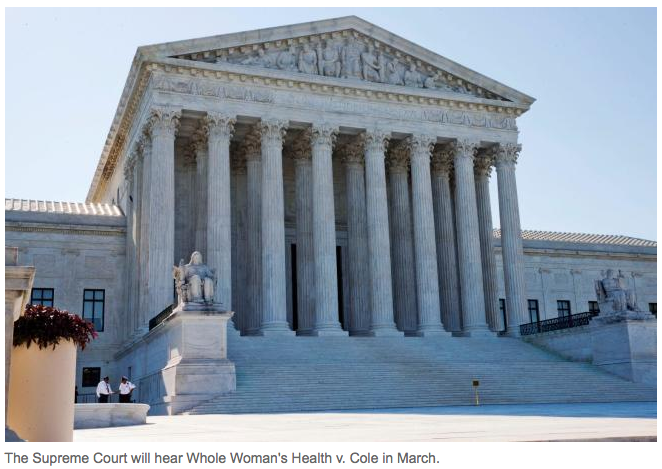On March 2, the Supreme Court will hear Whole Woman’s Health v. Cole, its first abortion case in more than 20 years. The case looks at a 2013 Texas law that plaintiffs say gets in the way of a woman’s constitutional right to end a pregnancy. The court will decide whether the state’s rules place an “undue burden” on that right.
Known as HB2, the law places specific requirements on abortion clinics and has forced many to shutter across the state. It requires doctors to have admitting privileges at a hospital no more than 30 miles away, and sets clinic standards that are similar to those of surgical centers, including specifics on room and doorway sizes, staffing and anesthesia, among other things.
Those in favor of the Texas law say it is intended to protect women’s health, as it brings health and safety standards for abortion clinics more in line with those of other medical facilities.
Opponents argue the law is intended only as means to limit abortion. The lead plaintiff, an abortion provider called Whole Woman’s Health, has said the law isn’t medically necessary, is demanding and expensive, and interferes with women’s health care. A decision on the case is likely to come in late June.
The ruling will affect all states with similar abortion requirements.
If the Supreme Court rules against Whole Woman’s Health, Texas would be left with as few as nine abortion clinics, down from 19 clinics currently and down from 42 before the 2013 state law was enacted, according to the Center for Reproductive Rights. The state is the second-most populous in the nation, after California, and so large — nearly 800 miles long — that traveling from remote areas can make accessing care difficult.
Didn’t the Supreme Court already rule on abortion?
The Supreme Court has ruled on abortion two times, in addition to the case that will be argued in March.
Roe v. Wade established a woman’s constitutional right to an abortion in 1973, saying that states were not allowed to ban the practice as it fell under the right to privacy established under the 14th Amendment. The ruling did, however, allow states to enact abortion regulations to protect a fetus in the third trimester, with the exception of a pregnancy threatening a woman’s life. Roe also allowed states to enact regulations that protect a woman’s health during the second and third trimesters of a pregnancy.
In 1992, the court ruled in Planned Parenthood of Southeastern Pennsylvania v. Casey that states cannot place undue burdens on a woman’s constitutional right to abortion before a fetus is viable, meaning between 24 and 28 weeks.
It defined “undue burdens” as health regulations that can have “the purpose or effect of presenting a substantial obstacle to a woman seeking an abortion.”
If the Supreme Court has already ruled on abortion, why is it still a political issue?
Americans have grown more accepting of many social issues in the past two decades. In 1996, only about 25 percent of Americans thought marijuana should be legal and only 27 percent thought same sex marriage should be legal. In the more recent polls on those issues, both had support of about 60 percent of Americans.
That same shift has not happened on abortion. About 33 percent of Americans said they were “pro life” in 1996. In 2015, 44 percent identified as “pro life.” In the last six months, it appears support for legal abortion has gained a slight edge.
Source: Lindsey Cook and Kimberly Leonard, http://www.usnews.com
 Listen Online
Listen Online Watch Online
Watch Online Find a Station in Your Area
Find a Station in Your Area










 Listen Now
Listen Now Watch Online
Watch Online
